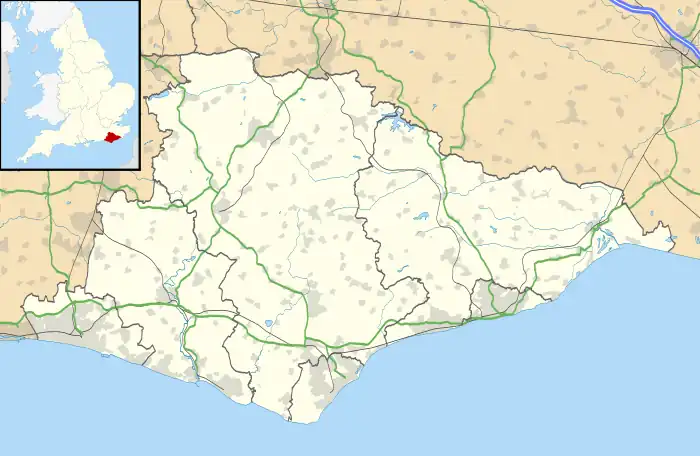| Pevensey Court House | |
|---|---|
 Pevensey Court House | |
| Location | High Street, Pevensey |
| Coordinates | 50°49′12″N 0°20′11″E / 50.8201°N 0.3364°E |
| Built | 1540 |
| Architectural style(s) | Medieval style |
Listed Building – Grade II | |
| Official name | The Court House and Wallby |
| Designated | 30 August 1966 |
| Reference no. | 1182588 |
 Shown in East Sussex | |
Pevensey Court House, formerly known as Pevensey Town Hall,[1][2] is a municipal building in the High Street, Pevensey, East Sussex, England. The structure, which currently accommodates a local history museum, is a Grade II listed building.[3]
History
The current building, which was commissioned to replace a 14th-century court house,[4] was designed in the medieval style, built in rubble masonry and was completed in around 1540.[5] It was then extended, with the construction of a north facing wing and the installation of a porch at the top of the external staircase, in 1830. A cement render finish was added at that time as well.[6][7][8]
The design of the enlarged building involved a main block which was orientated east to west together with a north facing wing. It featured an external staircase on the eastern side leading up to a porch on the first floor. The building was fenestrated by a prominent oriel window on the first floor at the end of the north facing wing, and by a casement window on the right-hand side of the main block, also facing north. The north facing wing was gabled and the main block was covered by a hipped roof. Internally, the principal rooms were a lock-up for incarcerating petty criminals on the ground floor,[9][10] and a courtroom, which was 18 feet (5.5 m) long and 14 feet (4.3 m) wide, as well as a robing room, on the first floor.[6]
The borough council, which had met in the council chamber, was abolished under the Municipal Corporations Act 1883,[11] and the assets of the borough, including the building, were transferred to the newly formed Pevensey Town Trust in 1890.[12][13]
One of the last people to be incarcerated in the prison cells was Betty Breach, who was found guilty of assaulting her drunken husband in 1887: after local protests, the magistrate who had sentenced Breach, apologised and released her.[14] The building was used to imprison a captured German airman and was also used as a mortuary during the Second World War.[6]
The court house subsequently served as a museum.[6] Exhibits accessioned to the collection included the seals of the borough which dated to around 1230, the official weights and measures of the borough, and a replica of a scene from the Bayeux Tapestry, depicting the landing of William the Conqueror at Pevensey in 1066, which was hand-embroidered in the 1980s.[15]
References
- ↑ Sussex archaeological collections relating to the history and antiquities of the county. Vol. 40. Farncombe and Company. 1896. p. 279.
- ↑ "Town Hall, Pevensey". Grenville Godfrey. Retrieved 12 September 2023.
- ↑ Historic England. "The Court House and Wallby (1182588)". National Heritage List for England. Retrieved 12 September 2023.
- ↑ "Pevensey". Visit South East England. Retrieved 12 September 2023.
- ↑ Locke, Tim (2011). Slow Sussex and South Downs National Park. Bradt Travel Guides. p. 232. ISBN 978-1841623436.
- 1 2 3 4 "Tour". Pevensey Court House. Retrieved 12 September 2023.
- ↑ "Pevensey Gaol". Prison History. Retrieved 12 September 2023.
- ↑ "Welcome". Pevensey Court House Museum. Retrieved 12 September 2023.
- ↑ Winbolt, W. E. (1928). Sussex. G. Bell & Sons. p. 44.
- ↑ "The Most Unusual Experiences in Eastbourne, England". Culture Trip. Retrieved 12 September 2023.
- ↑ Municipal Corporations Act 1883 (46 & 46 Vict. Ch. 18) (PDF). 1883. Retrieved 26 March 2023.
- ↑ "Pevensey Historic Character Assessment Report" (PDF). West Sussex County Council. 1 March 2008. p. 20. Retrieved 12 September 2023.
- ↑ Sacret, G. C. (1981). The Court House, Pevensey, Once the Smallest Town Hall in England. Pevensey Town Trust. p. 8.
- ↑ "Pevensey". Sussex Villages. Retrieved 12 September 2023.
- ↑ "Battle for Bayeux Tapestry: 'Don't forget Pevensey again'". The Argus. 20 January 2018. Retrieved 12 September 2023.